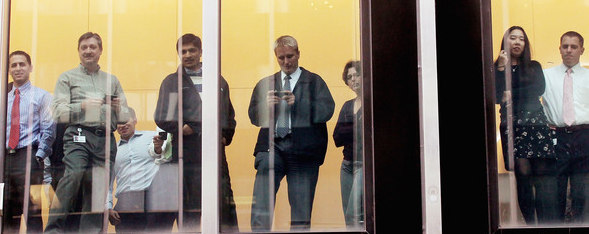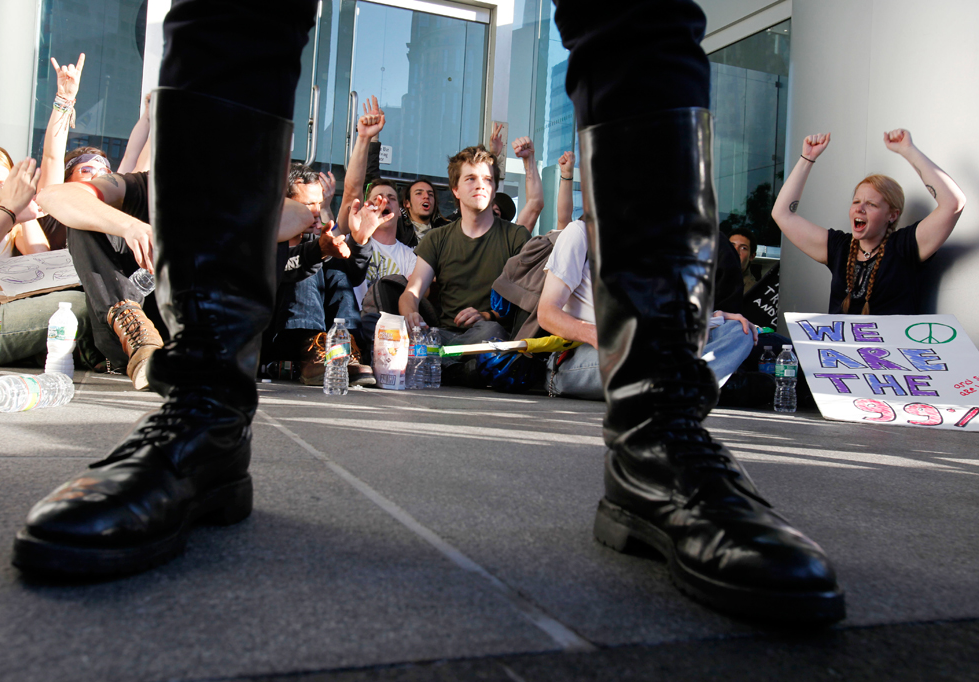According to spokespeople for the political right, such as Representative Paul Ryan, President Obama, emboldened by the occupy movement and fighting for his political life, has declared divisive class warfare on the 1%. We’ll ignore for the moment the recent CBO report that indicates that after-tax income for the top 1% is up 275% since 1990, while it has risen 40% for middle-income houses and 18% for those at the low end of the economic scale. And while we are at it we will also ignore the absolutely insane spate of “flat tax” plans being promoted by the various candidates of the week running for the presidential nomination of the republican party who seem to think that economic “equality” means lowering taxes on the 1% while raising taxes on just about everyone else so that we are all paying an equal proportion of our income. In short, we’ll ignore the fact that class warfare had been declared long before President Obama decided to challenge a “do nothing Congress” on jobs creation and Occupy Wall Street protestors took to the parks and the streets—and it wasn’t declared on the 1%.
Rather, I want to focus attention on the way in which the class warfare is being visually represented, or perhaps more to the point, the sense in which it is more or less invisible in news reports. As the photograph above suggests, the primary skirmishes are occurring in the street and the ground troops standing in opposition to the 1% are the occupy protestors. And as readers of this blog no doubt know, the web is awash with photographs of the “occupy” protests. And the scene is pretty much the same everywhere you look. Tent city encampments; protestors—young people mostly but not entirely—gathering in crowds, holding hands, marching, shouting (sometimes angrily, but not always so), and so on; protest signs that call attention to the economic disparity between the 1% and the rest; all manner of street theater, including men dressed in suits and ties while wearing pig masks, individuals with dollar bills taped to their mouth or covering their eyes, and men and women wearing Guy Fawkes masks; police dressed in riot gear (lots of police dressed in riot gear!); and of course the police rousting and arresting protestors, presumably in the name of safety and public order.
What is missing for the most part is any clear visualization of the 1% themselves. And the question is why? Part of the answer, of course, is that its not that kind of war. Class warfare is not fought with guns and bombs—though of course the history of anti-union strike breaking in the 20th century might suggest otherwise. It is fought primarily with tax codes and all other manner of rules and regulations designed to promote the interests of the moneyed classes. And those simply can’t be photographed. One might call it an invisible war but for the pesky facts that I started with and the myriad problems exacerbated by the lack of regulations on the financial industry that led to the debacle of 2008, including house foreclosures, double-digit unemployment, and anemic economic growth despite the fat that corporate profits are up.
But part of the reason, I think, is that those who stand with the 1% simply don’t want to be seen. They know what they are doing and the effects that it is having or will have, and they are simply willing to go on doing it anyway. Unlike Gordon Gecko, they are not willing to announce piously that “greed is good,” but by the same token they aren’t willing to give any ground. They refuse to engage with the protestors, perhaps with the assumption that if they ignore them they will eventually run out of energy and disappear, once again allowing the war to continue in all of its invisibility. And so they stay outside of the view of the lens of the camera. This, by the way, might be one of the key difference between Occupy protests and Tea Party Protests; in the later we typically see the opposition joining the debate, but here that almost never happens. The other difference, of course, is that we rarely if ever see the police arresting Tea Party protestors.
Every once and awhile, however, the masters of the universe slip up and allow themselves to be seen, such as in this photograph taken last week at a protest outside of J.P. Morgan Chase in Manhattan.

The image is altogether telling. Taking a break from the world of high finance, they gawk at the protestors below. They don’t seem to have a care in the world, and they surely don’t seem to have any real concerns for what is taking place on the street below as anything other than a passing curiosity. The guys on the left are snickering. The man in the middle appears to be texting a friend. The man and the woman on the right seem altogether bored. In another such photograph a women uses her phone to photograph the crowds below. The overall attitude is one of nonchalant and bemused indifference. And in a few moments they will no doubt return to their desks and computer screens secure in the belief that this is a war that can be won simply by not showing up. After all, the law seems to be on their side—literally.
One can only wonder how long the class war will remain that kind of a war.
Photo Credits: Michael Dwyer/AP; Mario Tama/Getty Images

I took the time to watch game 7 of the World Series last Friday night, and I can say with some assurance, and to no one’s surprise, that the 1% is highly visualized in commercial media. Even as our facebook apps lit up throughout during the game with every new post in support of OWS, we concurrently suffered repeated commercials for (JPMorgan) Chase national bank, Bank of America, and a wide assortment of luxury automobiles that none of us can afford. The 1% was literally in front of our faces. By the middle of the third inning we had a game going during every commercial break where we would see who could be the first to point out that the 1% was selling us something. We shouted “one percent” so many times that it had lost its appeal by the seventh inning stretch.
While your point here is about the lack of photojournalistic representation of the 1% in this particular OWS/class struggle, it’s worth pointing out that we can’t say the same about representation of the 1% in visual culture more broadly. For visual representation of the 1% – in all forms of mass media, conspicuous consumption, and indeed, accumulated capital – is nothing if not ubiquitous in today’s late modern public culture.
As for visualization of class warfare itself, that does not, as you point out, lend itself to easy editorial depiction. But visual culture does tell the tale. I am tempted here to think of something like hegemony, and how the monied class represents, depicts, indeed advertises itself and its value systems as the status quo. Advertising culture thus comprises at least one front in visualized class warfare. The 1% does, in fact, want to be seen, just not in front of photojournalists’ lenses and not on the OWS front.
Isn’t it more likely that those people in the window are just employees? Just because they work in finance doesn’t mean they’re 1%.
Phil: Your point re advertising culture is well taken. That said, my guess is that you didn’t actually see the 1% but rather institutions that stand in for them (then again, I guess the Supreme Court has established that corporation are individuals). They thus operate in that space between the visible and the invisible, and in that sense they are fighting something like a war of attrition that doesn’t require their most active presence. In someways, I suppose, it is rather like fighting a foreign war with drones.
Jason: I’m not sure about “more likely,” but your point too is well taken. That said, its hard to believe that some of them don’t imagine their upward career path to becoming “masters of the universe.” And in any case, it seems clear that they identify with the 1% “above” and not the 99% “below.” If, however, you are totally correct that only reinforces the larger point I was trying to make, that the 1% remain palpably invisible in battle, shielded by the law in the first photograph and hiding behind the veil of their workers in the second.
The 1% don’t stand in office windows in their shirt sleeves. But their proxies do! The upper floor spectators and the street level occupants only have few degrees of separation. (The 99% “below” is dramatically stratified, too.) What a luxury to be able to Occupy Wall Street and dress in ironic costumes! White, middle-class angst at its finest. Cynical, sure, but one could argue that this is a case of the (visible) privileged protesting the (invisible) ultra-privileged. Occupy a poor neighborhood and protest extreme poverty, insufficient health care, bad schools, and inferior housing, maybe? Nothing fun and media friendly about that.
With your point, John, and Jason’s comment in mind, what I was thinking when I first saw this shot, or actually, a variant of it, is that the minions of the system are trapped in the middle, and captured behind glass, like animals in a zoo.
MIchael — Yes and No. I had the sense of a zoo experience here also BUT my sense is that they are not like the animals but the folks looking out onto the nature preserve where all the “animals” are.
The documentary “Born Rich” offers some glimpses into the lives of the 1%.
http://topdocumentaryfilms.com/born-rich/
Then there’s the “Occupy George” project (to which a student from a visual rhetoric seminar alerted me). It’s a Tufte style infographics approach to spreading the word about wealth distribution.
http://occupygeorge.com
Finally, we tend to picture the 1% either when they transgress (Madoff, Skilling), or when we’re celebrating their success (MTV’s “Cribs”). Testimony, I suppose, to the uneasy mix of ambition and resignation that seems to characterize our present relationship with capitalism.